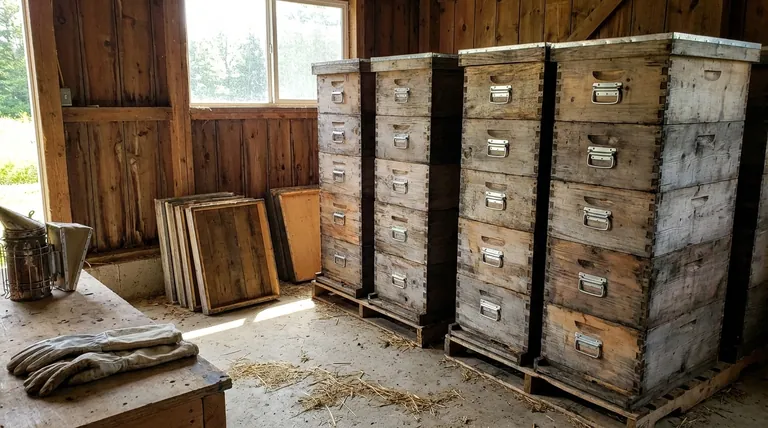As a standard beekeeping practice, storing unused hives in a stacked configuration is the most effective method. This approach maximizes storage space, protects the wooden components from pests like mice, and keeps the equipment assembled and ready for rapid deployment when you need to capture a swarm or start a new colony.
The way you store your beekeeping equipment in the off-season directly impacts its longevity and your readiness for the season ahead. Stacking is not just about tidiness; it's a strategic method for protecting your investment and streamlining your operation.

The Core Benefits of Stacking Hive Bodies
Storing your hive boxes vertically in a "stack" mimics their natural setup in the field. This simple technique offers three distinct advantages that address the most common challenges of equipment storage.
Maximizing Storage Efficiency
Hive components are bulky. Stacking them vertically makes the most of your available floor space in a garage, shed, or barn.
This allows you to store a significant amount of equipment in a compact footprint, keeping your workspace organized and uncluttered.
Ensuring Rapid Deployment
Beekeeping often requires quick action, especially during swarm season.
Having your hive bodies, bottom boards, and covers stacked and ready means you can assemble a complete hive in minutes. This readiness can be the difference between capturing a valuable swarm and losing it.
Creating a Pest-Resistant Fortress
Mice and other rodents seek out sheltered spaces to build nests during the colder months. An empty, single hive box lying on its side is an open invitation.
By stacking the boxes securely on top of each other with a solid bottom board and a sealed top cover, you create a fortress that is much more difficult for mice to access and inhabit.
Understanding the Trade-offs and Best Practices
While stacking is the superior method, its effectiveness depends on proper execution. Simply piling boxes can lead to other problems if not done with care.
Avoid Trapping Moisture
The single biggest risk to stored woodenware is moisture, which leads to mold, mildew, and rot.
Ensure every component is completely dry before storing it. Storing equipment in a well-ventilated, dry location like a shed or garage is crucial. Avoid damp basements or storing directly on a concrete floor where moisture can wick upwards.
Manage Internal Components Separately
While the hive bodies should be stacked, the internal frames often require separate attention.
Frames with drawn comb are a target for wax moths. Storing these frames separately, where they have access to light and airflow, can help deter these destructive pests. Wooden frames without comb can be disassembled for even more compact storage.
Ensure a Secure and Stable Stack
A tall, wobbly stack of heavy wooden boxes can be a safety hazard.
Always start with a level surface. A solid bottom board creates a stable base. If the stack becomes very high, consider placing it against a wall for additional support or breaking it into multiple, shorter stacks.
How to Store Your Hives Effectively
Your specific storage goals will determine the best way to configure your stacked equipment.
- If your primary focus is long-term protection: Ensure the stack is tightly sealed with a bottom board and a secure top cover, leaving no gaps for pests.
- If your primary focus is swarm readiness: Keep at least one complete hive stack assembled and easily accessible so you can grab it at a moment's notice.
- If your primary focus is maximizing space: Disassemble and clean all internal frames, storing them separately from the tightly stacked hive bodies to achieve the most compact configuration.
Properly storing your equipment is a simple discipline that pays significant dividends in the health and efficiency of your apiary.
Summary Table:
| Benefit | Key Advantage |
|---|---|
| Maximizes Storage | Saves significant floor space in garages or sheds. |
| Ensures Rapid Deployment | Allows for quick hive assembly to capture swarms. |
| Pest-Resistant | Creates a fortress against mice and rodents when sealed properly. |
Ready to streamline your beekeeping operation with professional-grade equipment?
As a leading wholesale supplier to commercial apiaries and distributors, HONESTBEE provides the durable, high-capacity equipment you need for efficient storage and management. Protect your investment and be swarm-ready.
Contact HONESTBEE today to discuss your wholesale needs and elevate your apiary's efficiency.
Visual Guide

Related Products
- Professional Drop-Style Hive Handles for Beekeeping
- HONESTBEE Classic Pry Bar Hive Tool with High Visibility Finish for Beekeeping
- Beehive Entrance Discs Plastic Bee Entrance Disc for Bee Hives
- Yellow Plastic Bucket Pail Perch for Beekeeping
- Long Langstroth Style Horizontal Top Bar Hive for Wholesale
People Also Ask
- What is the role of gloves in beekeeping, especially for beginners? Build Confidence & Safety
- How much time does it take to do beekeeping? A Realistic Breakdown for Beginners & Pros
- Why is proper beekeeping equipment important? Essential for Safety and Hive Health
- Why are hive tools painted in bright colors? Prevent Losing Your Essential Beekeeping Gear
- What equipment do I need to start beekeeping? The Essential Beginner's Guide



















